My interest thus aroused, and knowing that on Friday 3 and Saturday 4 March there were open door events at observatories all over Flanders, I decided to check out that telescope myself. It turned out that Volkssterrenwacht Armand Pien operated its observatory on top of a university building smack in the middle of Ghent (no ideal situation, light pollution being a serious issue and all). If you follow this link, you see that particular cupola housing the Van Monckhoven telescope.
I got there on Friday evening at almost 10pm.
Boy I was not to be disappointed:
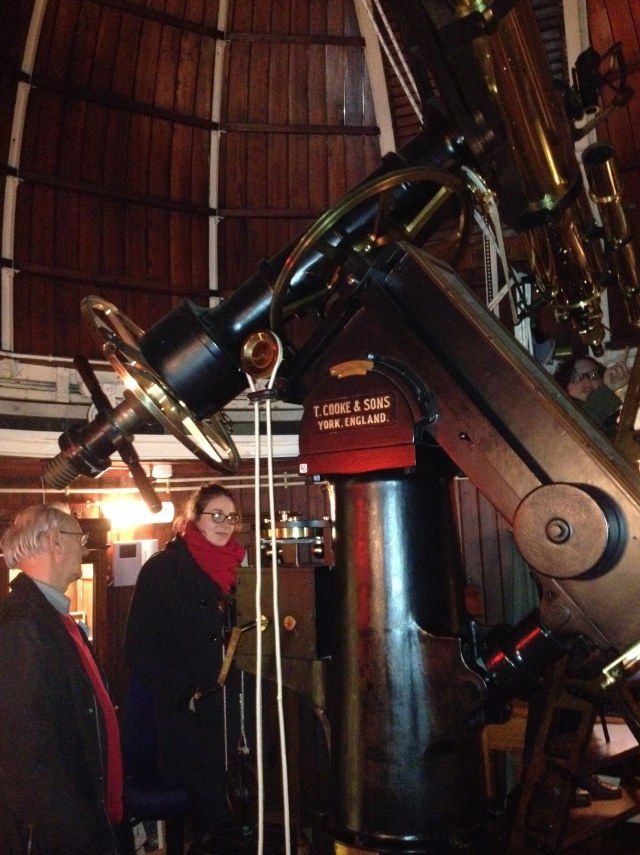
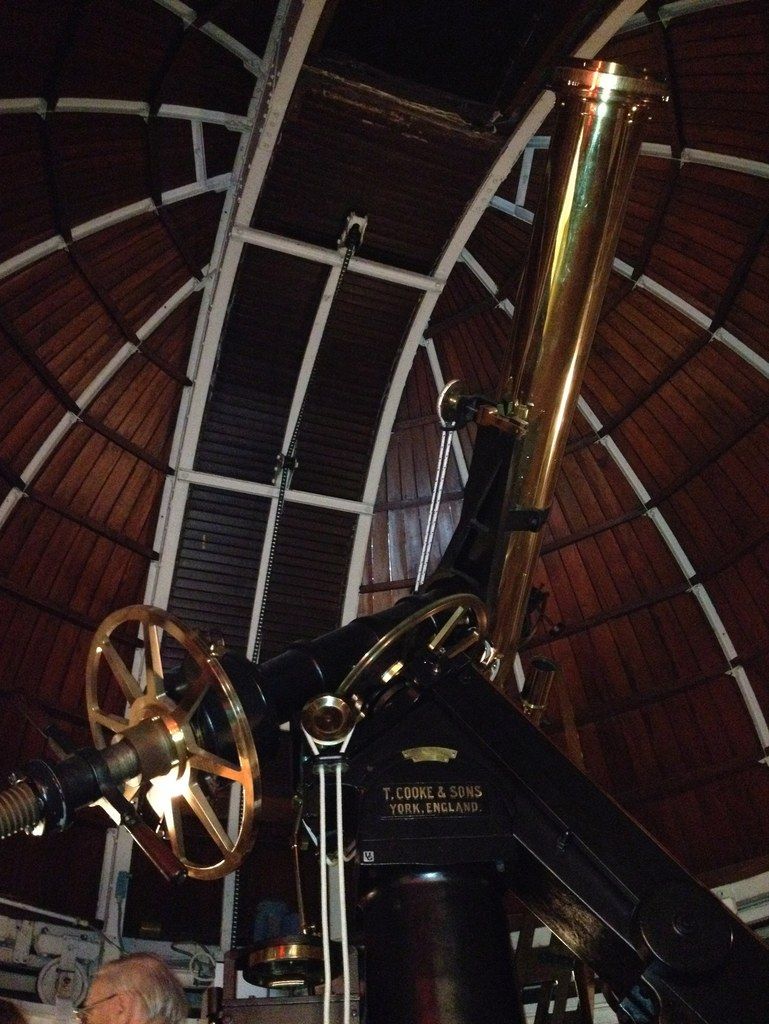
WOW. I said 'WOW'! What a discovery! The Van Monckhoven telescope turned out to be a refracting telescope manufactured around 1880 by a York, UK based company with a fascinating history, T.Cooke & Sons.
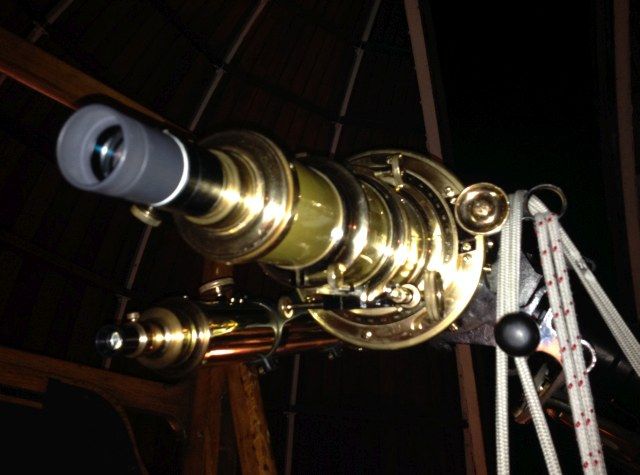
A refracting telescope, or in short refractor, uses a lens as its objective to form an image. The image you see is inverted, so north becomes south and vice versa. The magnification is calculated by dividing the focal length of the objective lens by that of the eyepiece. The Van Monckhoven telescope allowed for changing the objectives, so that different magnifications could be obtained. When I was there, the particular magnification was 63.
Unfortunately, the sky overhead turned out to be very cloudy. Only towards the horizon there was no cloud deck, although there were fast-moving chasing clouds. The Moon was low however, the observatory's chief pointed the telescope to our nearest neighbor. And this is what I saw:
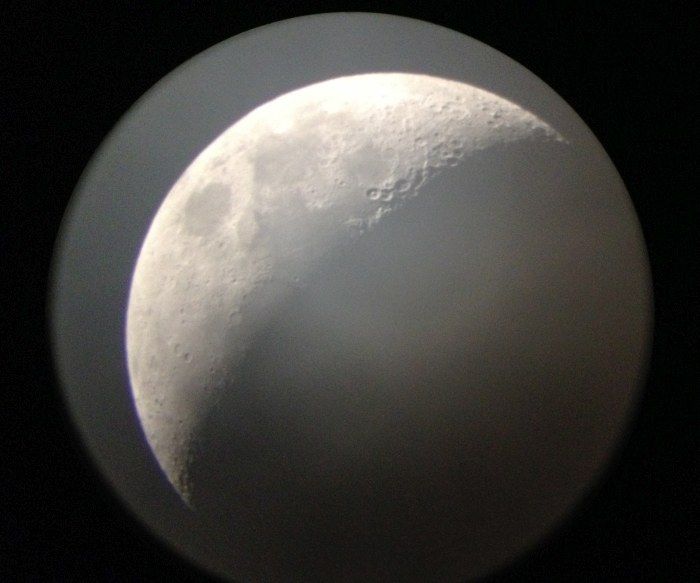
Mag-ni-fi-cent! And what a privilege to glimpse my best view of the Moon evah through a historical apparatus like this one!
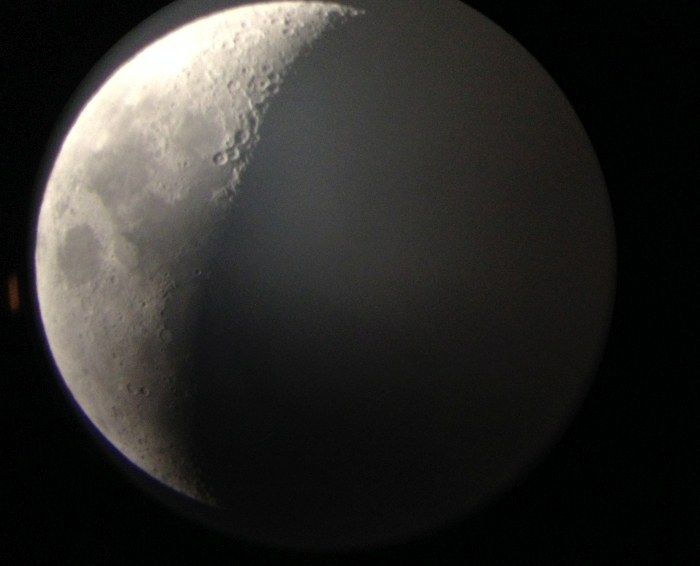
The lunar phase being a waxing crescent, I could see perhaps 30 per cent of the right side, with the segment tilted to the right of course (in the northern hemispere, waxing crescent means the right side moonlit between 1 and 49 per cent). Keep in mind that with my naked eye, the sunlit segment was at the bottom right, but the Van Monckhoven being a refractor, what you saw through the device became inversed, so that same segment was visible on top and to the left.
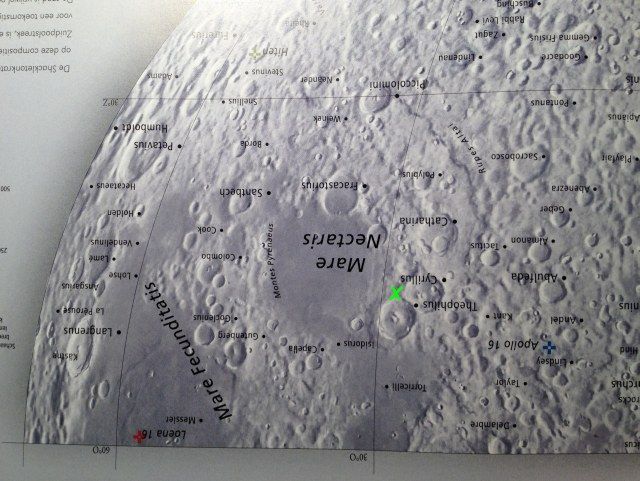
All in all there were not too many details too discern, but what struck me most of all were two craters so close to another that their rims at the point of contact became as one (I marked them with a green "X"), plus darker areas above and to the left. I decided to check them out when I got home.
I couldn't find any decent Moon map on the net (but then I didn't search for too long), so I photographed the south pole of a decent map in "De Maan. Mysterie, Natuur en Exploratie", a decent Tirion Natuur book I bought in 2010. I inverted the image so that I could more easily compare it to my photos - which is why the characters you see are inverted, of course.
It did not take me long to identify the Moon features I could see: very quickly it was established that the two craters were Theophilus (on my photo, the one to the left) and Cyrillus (the one to the right). They were named after Theophilus of Alexandria and Cyrillus of Alexandria (later Saint Cyril), 4th-century Coptic Popes. Keep in mind that the Moon is bigger than you think, since both craters have a diameter of around 100 kilometers! Check out a fantastic shot of Theophilus in this Lunar Orbiter 3 photograph, taken in 1967.
The dark areas on the Moon are volcanic lava plains and called mares (seas), as I'm sure you know, and once I was certain of the identity of the two craters, it was clear that the mare just above Theophilus ('above' in my photo at least, in reality that night it was to the southeast) was Mare Nectaris, the "Sea of Nectar".
It followed that the mare to the left of Mare Nectaris, (Sea of Fertility) but separated from it by a lighter area, was the Mare Fecunditatis, an 840-klom in diameter crater which has the distinction of being the area from where the first automated rock samples took place, by the Luna 16 probe in 1970. (on my map, it's the red cross marked Loena 16). Oh those Russians! How I admire their engineering prowess! Too bad their talents didn't lead to full fruition because of the communist system.
Somewhat more to the left (on the photos) another mare follows, Mare Crisium (Sea of Crises). It is also separated from the previous one by a lighter area, so that the three mares, Crisium, Fecunditatis and Nectaris, appear as three dark, comparable spots forming a slightly bent arc. Of interest is that Mare Crisium is the landing are of three other Luna probes, and has also the small crater Picard in it, named after Jean-Luc Picard, the Enterprise Commander of the second Star Trek series (at least if you were processed by the Chicago Public Schools system).
But then, if we gaze to the right from Mare Crisium, after hopping over a diamond-shaped plateau named Palus Somni, we arrive at what is probably the sole Moon mare of which the name may ring a bell with everyone, even common core products: Mare Tranquillitatis!
Mare Tranquillitatis, or Sea of Tranquility (we call it the Zee der Stilte, or Sea of Silence, in that coarse peasant's language you know), will forever be remembered as the place where Apollo 11's Eagle touched down and Man, in the person of Neil Armstrong, set first foot on another celestial body. The landing spot at 0.8° N, 23.5° E has been named Statio Tranquillitatis because Armstrong, upon touching down, radioed the flight controllers on Earth: "Houston, Tranquility Base here. The Eagle has landed."
Van Monckhoven's telescope was far too weak too discern any human artefacts left on the Moon. No Earth-based telescope can do that... not even the Hubble Space Telescope. But at least this 137-year old magnificent apparatus allowed yours truly to see for the first time, with my own eyes, the landing area where the first humans to visit the Moon came down.
And for that, and for the fact that our readers can do so too via this here humble blog...
... I am very grateful.
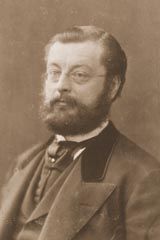 Finally, who was Van Monckhoven? He was a Belgian chemist, physicist, inventor, author and photographic researcher, born Désiré Charles Emanuel van Monckhoven in 1834. Extremely talented, he wrote a book on chemistry when he was 16 (!). Two years later, another book, "Elements of Physics" appeared. From this period dates also his interest in photography, and after high school he began working for Charles D'Hoy, an early photographer. In 1855 already, he published 'Traite de photographie sur Collodion' in Paris, followed by 'Traite general de photographie' in 1856, which became a standard work. In 1857 he started studying physics at the University of Ghent, to become Doctor in Physics in 1862. In 1866 he moved to Vienna, where together with a certain E. Rabending he operated a successful photo studio. When Van Monckhoven returned to Ghent in 1870, his name was made, not least because he had written several of the earliest books on photography and photographic optics. His original French works (remember that at the time, although Ghent was a city in Flanders, Flemish was considered a coarse peasant language) were later translated to English and even other languages, so that he became known throughout Europe. Van Monckhoven also invented or developed an enlarger (1864), a dry collodion process (1871), and improvements of the carbon print process (1875–80), and of silver-bromide gelatine emulsions.
Finally, who was Van Monckhoven? He was a Belgian chemist, physicist, inventor, author and photographic researcher, born Désiré Charles Emanuel van Monckhoven in 1834. Extremely talented, he wrote a book on chemistry when he was 16 (!). Two years later, another book, "Elements of Physics" appeared. From this period dates also his interest in photography, and after high school he began working for Charles D'Hoy, an early photographer. In 1855 already, he published 'Traite de photographie sur Collodion' in Paris, followed by 'Traite general de photographie' in 1856, which became a standard work. In 1857 he started studying physics at the University of Ghent, to become Doctor in Physics in 1862. In 1866 he moved to Vienna, where together with a certain E. Rabending he operated a successful photo studio. When Van Monckhoven returned to Ghent in 1870, his name was made, not least because he had written several of the earliest books on photography and photographic optics. His original French works (remember that at the time, although Ghent was a city in Flanders, Flemish was considered a coarse peasant language) were later translated to English and even other languages, so that he became known throughout Europe. Van Monckhoven also invented or developed an enlarger (1864), a dry collodion process (1871), and improvements of the carbon print process (1875–80), and of silver-bromide gelatine emulsions.I suspect that his intense interest in photography led to his procuring the telescope which would in time be named after him, but here the mystery starts, for I haven't been able yet to check out how the apparatus came to be such a prominent part of the Armand Pien Observatory. What I did learn was that for a very long time it was forgotten after Van Monckhoven's death in 1882, that it was found in a crate in the early nineties (of the LAST century, to be sure!) and that subsequently it was painstakingly restored, and installed under the observatory's main dome in around 1996. To ensure stability, it was bolted on a concrete column some thirty meters high.
If you happen to be in Ghent on the appropriate moment (generally Wednesday evenings), you have the chance to check out Van Monckhoven's famous telescope for yourself.
And if you now feel a sudden keenness to take up astronomy, download Stellarium. You will not regret it - I guarantee!
MFBB.
No comments:
Post a Comment